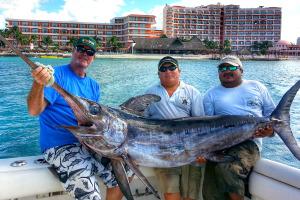The swordfish, known for its legend and intrigue, captivates the angling community with its vast size and elusive nature. The journey to catch one combines both art and science, requiring a blend of skill, technique, and knowledge. Dive into this comprehensive guide to unveil the mysteries of the swordfish, their habitats, expert fishing methods, and the importance of conservation for future generations.
Summary
- Biology of Swordfish: Swordfish, known scientifically as Xiphias gladius, can grow over 9 feet and weigh up to 1,500 pounds. Their unique sword-like bill aids in hunting.
- Habitat: They inhabit the Atlantic, Pacific, and Indian Oceans, seeking areas where warm and cold water masses converge.
- Best Times: Seasonal migrations and daily feeding patterns dictate the best fishing times. Monitoring factors like temperature and moon phase can also be advantageous.
- Equipment: Specialized heavy tackle, including robust rods, reels, and other gear, is essential for success.
- Bait and Lures: Oily fish and squid are top choices. Natural movement and scent trails are crucial.
- Fishing Techniques: Methods like drift fishing, high-speed trolling, deep dropping, and kite fishing are employed based on conditions.
- Conservation: Sustainable practices and regulations have helped protect swordfish populations from overfishing.
- Dedication: Successful swordfishing demands dedication, practice, and respect for the sport.
The Art and Science of Catching the Magnificent Swordfish
The swordfish is a creature of legend and intrigue. This powerful apex predator has captured the imagination of anglers for centuries with its imposing size, fighting spirit, and elusive nature. However, catching a swordfish requires skill, technique, and knowledge. In this comprehensive guide, we will explore the biology of the swordfish, the best methods and gear for catching them, tips from expert anglers, and the conservation efforts that are helping preserve swordfish populations for generations to come.
Bonus Video: Swordfishing – Daytime Broadbill Seminar with RJ Boyle
Expert on midday swordfishing in Florida RJ Boyle presents a session on technical matters related to dropping broadbill swordfish. In addition to tackle and rigging, he covers boat steering, drift setting, currents, bait targeting, and identifying bites from fish in the vicinity. RJ provides expert advice on all facets of daylight swordfish fishing for thirty minutes while he is on the swordfish rig… View Short Trailer Below or Learn More Here
An Introduction to the Mighty Swordfish
The swordfish (Xiphias gladius) is a marine pelagic fish renowned as an exceptional game fish. Reaching lengths over 9 feet and weights approaching 1,500 pounds, the swordfish is the definition of a monster fish. They are native to tropical, subtropical and temperate waters worldwide. Their characteristic elongated, flattened bill gives them their name, as it resembles a sword. This unique adaptation allows them to slash through shoals of fish and incapacitate prey.
Swordfish are sleek, streamlined swimmers capable of bursts of speed over 60 mph. They spend the majority of their time in epipelagic and mesopelagic zones of the ocean, hunting for prey during vertical migrations. Swordfish undergo extensive migrations, travelling thousands of miles between feeding and spawning grounds. They follow temperature boundaries and can cover vast distances searching for food.
Where to Find Swordfish
Swordfish inhabit a widespread range, found in the Atlantic, Pacific and Indian Oceans. In the Western Atlantic, some of the most popular fishing grounds include the Gulf Stream off Florida, Georges Bank off New England, and the Grand Banks off Newfoundland. Other notable fisheries exist off California, Australia, the Mediterranean Sea, Brazil and beyond.
When targeting swordfish, anglers look for temperature breaks along current edges where warm and cold-water masses converge. Rip lines, weed lines and areas of upwelling are also promising areas to find concentrations of bait fish that attract swordfish. Islands, underwater plateaus, reefs and canyons can provide structure that aggregates both prey and predator. Understanding oceanographic features is key to locating swordfish grounds.
Best Times to Catch Swordfish
The seasonal migration patterns of swordfish offer guidance on the optimal times to target them. In lower latitudes, swordfish catches peak during the winter and spring. In Florida, the fishing heats up November through April when the fish migrate south into warmer waters. The summer months offer great opportunity along the Northeast coast before the fall migration commences.
Daily feeding patterns also inform when to fish for swordfish. They typically feed at sunrise, sunset and throughout the night when prey species rise to surface waters. Daytime fishing can also be productive by targeting deep haunts. Experienced anglers carefully watch barometric pressure, wind, temperature, currents and moon phase to pinpoint when swordfish will be most active and aggressive towards baits.
Swordfish Tackle and Gear
Catching swordfish demands specialized heavy tackle designed for big game fishing. The muscular fish and extreme depths require robust gear to battle them successfully. Critical components include:
- Rods – 6 to 9 foot roller-tip or boat rods rated for 80 to 130 pound test line. Fiberglass and graphite composite blanks offer a perfect blend of strength, sensitivity and forgiveness needed to fight swordfish.
- Reels – Lever drag or star drag reels holding 500+ yards of 80 to 130 pound braided line. Electric reels provide mechanical advantage when hand cranking from great depths.
- Terminal Tackle – Large non-offset circle hooks from 12/0 to 20/0, connected to 400+ pound test wind-on leaders and 300+ lb test crimp sleeves. Swordfish have keen eyesight and will shy away from bulky tackle.
- Fighting Belt/Harness – Essential for taking the brunt of the force during the long fights. Quality harnesses spread pressure across the body.
- Gaffs – Strong gaffs with long shanks are needed to hoist large swordfish out of the water. Flying gaffs strike and retrieve the fish in one motion.
Best Baits and Lures for Swordfish
Choosing the right bait and keeping it fished near the bottom where swordfish feed is paramount. Naturally oily fish like mackerel, herring and sardines produce a strong scent trail to lure predators in. Squid is another excellent choice. Large 5-10 lbs baits allow the scent to travel farther.462
When fishing natural baits, care must be taken to keep them swimming and looking lifelike. Bridles, daisy chains and skirts are used to add action and vibration. Dredges tease fish to the surface to feed. Lures offer convenience, predictable action and eliminate bait damage. Popular lures include large rubber squids, jigs and plugs. Electronics make it possible to monitor baits and detect subtle bites.
Swordfish Fishing Techniques
Here are some of the most effective techniques used to fool swordfish:
Drift Fishing
Allowing baited lines to drift over structure where swordfish hunt is a classic method. Multiple lines fished at different depths find zones holding fish. Modern electronics enable anglers to drift over specific contours and bottom features.
Trolling
Trolling lures mimics the behavior of fleeing prey. Covering ground helps locate scattered fish. Lures are deployed using planers and wire line to achieve desired running depth.
Deep Dropping
Specialized electric gear enables anglers to target swordfish in the daytime, when they are at depth. Send baits to depths exceeding 1,500 ft where trophy-sized fish dwell. Extreme precision in bait placement is required.
Night Fishing
Swordfish become much more active feeding on the surface after dark. Illuminated floats, chemical lightsticks and luminescent lures all help induce explosive strikes under the cover of night.
Kite Fishing
Suspending live baits from kites positioned off the bow keeps baits skipping along the surface. Kites place baits away from engine noise where weary fish will bite.
Casting to Surface Fish – In Southern California swordfish are known to bask at the surface. Site casting rigged live baits can be very effective.
Each technique has advantages in different conditions. Mastering a variety of methods is the key to consistent success.
Fighting and Landing Swordfish
Hooking into a swordfish is merely the beginning of the battle. Once hooked, these gladiator fish unleash their raw power. A swordfish will make blistering initial runs peeling off hundreds of yards of line. Experienced anglers bow to the first runs, keeping steady pressure to avoid pulling hooks. As the fight progresses, pumping and reeling regain precious line.
Gaining the upper hand requires resolve and technique. The rod and reeler work in unison wearing the fish down. There is no room for mistakes battling a fish that can top 500 pounds. If the hook pulls or the leader parts, hours of effort are lost. The fight is not over until the swordfish is dispatched and safely boarded.

Swordfish Conservation
Swordfish have been fished commercially since ancient times. Consumer demand for swordfish peaked in the 1990’s, putting pressure on populations. However, forward-thinking management has helped curtail overfishing.
Strict quotas, minimum size limits, monitoring and fishing bans in certain areas have all aided conservation efforts. The West Atlantic swordfish stock has fully rebounded and is now considered sustainable. Eco-conscious anglers can enjoy the challenge of swordfishing while also promoting responsible practices.
By following regulations, using circle hooks, and carefully releasing unwanted catches, recreational anglers help protect swordfish stocks for the future. Planning trips when swordfish congregate also minimizes unnecessary deaths from sharks and marine mammals. Through stewardship and education, swordfish will continue thrilling anglers for generations.
Swordfishing Success Takes Dedication and Practice
Many dream of catching a broadbill swordfish, but only those willing to put in the work achieve success. It requires commitment to gain the knowledge, skills and equipment needed for these epic battles. Veterans spend decades mastering the many intricacies.
For reward, swordfishing offers the chance to test yourself against one of the ocean’s greatest big game fish. The memories made during the long nights, close calls, victories and defeats last a lifetime. While not easy, those who put in the time on the water will be handsomely rewarded. When everything comes together, all the preparation culminates in the moment when the leader touches the rod tip and a swordfish appears by the boat. That is a feeling like no other.
Conclusion
The swordfish is an iconic creature revered by anglers. Though elusive and challenging to catch, those willing to take up the challenge will find it immensely rewarding. Successful swordfishing relies on understanding their biology and behavior, fishing during peak conditions, having properly outfitted boats and tackle, and mastering specialized techniques. With responsible practices, swordfish populations will provide thrilling fishing opportunities for generations to come. For adventurous anglers, few experiences compare to facing off against a broadbill swordfish and winning the battle.
Seth Horne In The Spread, Creator

